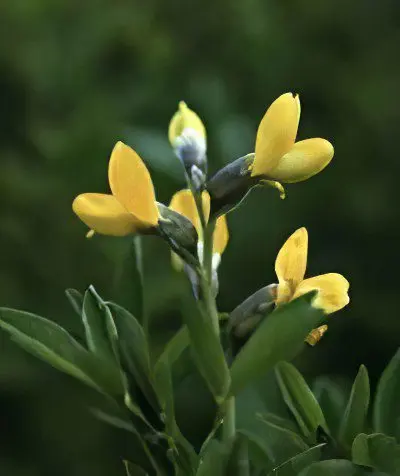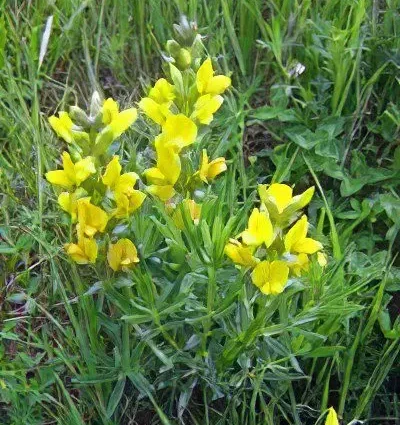Contents

Thermopsis is an unpleasantly smelling perennial plant with long creeping rhizomes and a simple erect stem. Such a herbaceous plant has trifoliate grayish-green leaves of a lanceolate shape. Leaf plates are supplemented with large stipules. Yellow large flowers of irregular shape are collected in graceful racemes. The fruit of thermopsis is represented by a linear bean with a small spout.
Such a peculiar plant blooms in June and July. Around August, the seeds begin to ripen. Thermopsis is found in the Trans-Volga region and in the steppe regions of southwestern Russia. It prefers saline wet meadows, grassy slopes, fields and steppes.
Useful properties of thermopsis
The presented grass contains large quantities of substances useful to humans, esters and alkaloids. Various drugs based on thermopsis have a powerful expectorant effect. The tannins and saponins contained in the grass have a rather versatile effect on the human body. Such a plant is able to increase blood pressure, stimulate appetite, increase the tone of the uterus and inhibit the nodes of the autonomic nervous system. Thanks to anagarin, the herb has curare-like properties.
In modern medical practice, various preparations containing thermopsis are used as an expectorant and anti-inflammatory agent for various colds and infectious diseases. Healing infusions of herbs contribute to the rapid removal of sputum from the respiratory tract, excite breathing and relieve spasms of peripheral vessels. In addition, thermopsis is indicated for hypotension, as well as to stimulate weak labor activity. The powder of this dry plant produces an insecticidal effect.
An herb such as thermopsis has been proven to be effective as an antihelminthic. Modern doctors prescribe the herb not only for inflammation of the lungs and bronchitis, but also for fever, flu, headaches and intestinal atony.
Application of thermopsis
All kinds of infusions and decoctions of herbs have a pronounced stimulating effect on the excretion of sputum. It is manifested by increased secretory functions of the bronchial glands, accelerated secretion evacuation and increased activity of the smallest ciliated epithelium, as well as an increase in smooth muscle tone due to the vagotropic effect.
Thermopsis is indicated for both adults and children. It is no coincidence that it is part of many complex medicinal teas and herbal preparations. In chronic bronchitis and pneumonia, it is difficult to do without such a universal remedy. To prepare an infusion for 6 mg of herbs, take one glass of boiling water and infuse the remedy for about eight hours. Adults should take it up to 5 times a day, 1 tablespoon. Children’s dosage is 1 tablespoon no more than three times a day.
Often, thermopsis preparations are prescribed for low blood pressure, at the same time, due to special adrenergic mechanisms of action, they also enhance the function of the adrenal glands. The ganglioblocking properties of the plant should also be noted. When prescribing medicinal preparations based on thermopsis, it is recommended to be careful, since thermopsis is considered a potent substance.
Thermopsis from cough

Popular cough tablets based on thermopsis have been successfully used for decades, despite the availability of more modern drugs. Such a wonderful expectorant is indicated for various ailments of the bronchopulmonary system.
When taken orally, these tablets are absorbed in the gastrointestinal tract itself, and then immediately enter the bloodstream and into the mucous membrane of the trachea and bronchi, providing a powerful irritating effect. This causes reflex secretion of thick bronchial secretions. The motor activity of the muscles of the bronchi also increases, which contributes to expectoration and the complete removal of pathogenic sputum.
Thanks to the sodium bicarbonate contained in the tablets, they have a pronounced decrease in the viscosity of sputum. Thermopsis is indicated for unproductive dry cough.
How to take thermopsis? For bronchitis and pneumonia, as well as for acute inflammatory diseases of the respiratory tract, adults are prescribed to take the medicine 3 times a day, one whole tablet. The course of treatment should be at least three days. With prolonged or chronic inflammation, the course is extended to 5 days.
Thermopsis cough for children. Up to two years, it is recommended to give children an infusion of herbs, which is prepared at the rate of 100 grams of raw material per 0,1 ml of boiling water. The medicine should be taken in half a teaspoon no more than three times a day. For children under 6 years old, you can increase the dose of infusion to 1 teaspoon. Children from 6 to 12 years of age are shown a course of treatment of 0,5 tablets. To get the result, you should drink the medicine regularly for at least three days.
Thermopsis during pregnancy
Thermopsis contains pachycarpine, which during pregnancy not only enhances contractions of the muscles of the uterus, but also increases its tone. Therefore, various preparations based on such herbs are contraindicated for expectant mothers.
Only a doctor can prescribe treatment with thermopsis in the form of tablets not earlier than the last, third trimester of pregnancy.
Thermopsis with soda
In addition to infusions, dry and liquid extracts, effective powders are also used. This powder includes dried grass and soda. This drug is an excellent remedy for stimulating the respiratory center and increasing blood pressure.
This powder with soda and dry grass has a very strong insecticidal property. It is a poison of narrowly directed contact action.
Infusion of thermopsis
Thermopsis infusion is known for its expectorant properties. In high doses, it often leads to a gag reflex. By increasing the secretion of mucus in the respiratory airways, it significantly increases its own contractility of the bronchi. Stimulation of smooth muscles ensures the removal of sputum. Along with this, the infusion of thermopsis increases blood pressure. Mention should be made of the strong ganglioblocking properties of the presented drug.
For self-preparation of the presented herbal infusion, you will need at least 1 grams of water per 200 gram of dried herb. It is recommended to insist the remedy for about 40-50 minutes, and then strain. The dosage for an adult should not exceed 1 tablespoon, you can drink the drug up to 4 times a day.
Tincture of thermopsis
The expectorant properties of thermopsis tincture have been recognized by many modern doctors. The presence of saponins and alkaloids in such a preparation determines its powerful therapeutic effect. The agent is intended for reflex activation of the secretion of bronchial glands. In fairly small doses, thermopsis tincture excites the respiratory tract and removes phlegm from them.
Thermopsis extract
Thermopsis Dry Extract is a unique blend of dry powder of a specially standardized herb combined with milk sugar. One gram of the drug contains approximately 1% alkaloids. This tool is a light brown powder that dissolves easily in water. This extract is prescribed for adults 1 tablet. Depending on the severity of the respiratory tract disease, the drug should be taken 1 or 2 times a day.
Thermopsis lanceolate

Thermopsis lanceata is an unusual herbaceous plant, the height of which varies from 10 to 45 cm. The presented perennial has long creeping roots and thin, few roots. Straight, slightly branched stems have light grooves and pubescence before flowering. Trifoliate alternate leaves are on petioles. Their elliptical shape and one-piece edge make the leaf plates elegant. Young leaves are always densely pubescent and folded.
The sparse apical raceme represents the inflorescence. Flowers are located on short pedicels in the axils of the bracts. A small bean about 5 cm long has a linear protruding seed container. When the valves of the fruit open, kidney-shaped smooth seeds with a bluish-black coating appear. The lanceolate thermopsis blooms in June and early July. This species can be found on the territory of Siberia and Kazakhstan. As a rule, this plant chooses saline and sandy soils. It settles in river valleys, on small gravel slopes, as well as in wheat crops.
Contraindications to the use of thermopsis
The main contraindications in the use of this plant include hypersensitivity and ulcerative conditions of the stomach, as well as the duodenum. Overdose may cause vomiting.










